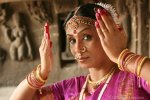
Our role
in conservation of Indian culture and performing arts
- Soumyasree,
Aurangabad
e-mail: devmudraa@yahoo.in
January 10,
2011
It is high time we took some serious
decision regarding these so called dance competitions on television that
they call Indian dance competitions but when any dance enthusiast with
Indian dance background goes to participate in these competitions on TV
and on stage, he is not selected and rejected. It's an insult to Indian
culture and arts.
The respected learned judges supposed
to be Indians talk as if they are alien to their culture and only talk
about foreign dance styles which barely take three months to master and
our Indian classical dances take six to ten years to just learn the art
form. So where do we stand? Should we allow our children and young generation
to forget our culture and go after these so called latest dance forms because
they don't get a standing anywhere in these competitions because of their
classical background?
It's our plea to all schools to introduce
Indian dance and music in their school curriculum and make a strong base
for all children to learn their roots and culture. It's a pity that once
upon a time there was a special slot for classical dance and music programs
on Doordarshan and everyone used to wait for those programs in the late
evenings and Sunday mornings, but where are they now? There are hardly
any shows or programs on the popular channels and prime time slots.
Poor DD Bharati programs still show
age old, at least ten year old shows on dance and culture. It's high time
we artistes make Indian classical dance reach all and make it audience
friendly and come out with more innovative themes. Usually general audience
reactions are like it must be difficult, we don't understand, it's too
high brow, we don't have patience to sit through these long concerts etc.
It was an encouraging scene in the Commonwealth Games inauguration and
closing ceremony to see some Indian classical and folk dances.
Actually, we ourselves lack the self
respect. When the foreigners come to India, they want to see authentic
culture and are not interested in so called western dances which are actually
Bollywood and not western. There's a wrong notion about western dance in
India.
I hope we all come up with innovative
ideas and promote our traditional arts. If the youth perceives, the whole
nation perceives it. Organisations like Spic-Macay are doing their bit,
but few attend the lecture-demonstrations and performances in colleges
and other places. Where are we lacking? To some extent in some cities like
Chennai, Kolkata, Mumbai, Delhi, Pune, Bhubaneshwar, some still go and
watch but looking at the plight of empty auditoriums for dance shows in
many places saddens us.
It's a good idea to include dance
in the school's regular syllabus and curriculum as introduced recently
by CBSC Board, though it will take some time to implement properly. A step
taken is a seed sown.

Soumyasree is a Bharatanatyam
dancer/ teacher and director of the dance institute Devmudraa - a movement
school, in Aurangabad.
Response
Dear Soumyasree,
All the SPIC MACAY programmes I
attended in Delhi as a student were well attended, usually packed to capacity.
In cities where they have managed to become a regular part of student activities,
they enjoy immense popularity.
As you rightly say, dance has become
highbrow, with dancers and intellectuals who can influence the younger
generation too busy flaunting its divinity and esoteric value. Just introducing
the subject in schools with teachers continuing to pass on half-baked ideas
about dance won't help. Dance in schools needs to be more inclusive. If
one begins by telling young students how difficult and highbrow an art
form is, they are bound to run away from it. While there are attempts to
interpret and teach dance in child-friendly ways, they are largely urban
initiatives accessible only to a section of children whose parents can
afford the high costs of such workshops.
Secondly, as pedagogues and sympathisers,
we must also rethink the language in which we contextualize the place of
dance in schools. Often, we refer to dance becoming a part of the 'mainstream'
curriculum or syllabus in 'mainstream' education. When we already tend
to view dance as an addition that is distinct from 'mainstream' education
and not as an ignored part of the mainstream, we begin to sideline it even
before we set out to achieve dance education goals.
Best,
Ranjana Dave
(Jan 27, 2011) |



